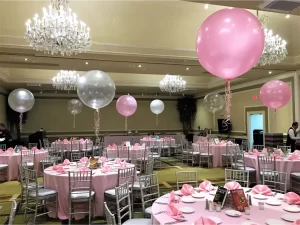Table of Contents
While both seem similar, their distinct properties dictate their floating abilities and practical applications. Let’s discuss in more detail the main differences to help you choose.

Composition, Properties and Bouncy
Helium and air, though seemingly similar, differ in composition and properties. Helium, a lighter-than-air gas, is inert and non-flammable, making it suitable for inflating balloons. Its low density gives helium-filled balloons their buoyancy, causing them to rise. On the other hand, air, primarily composed of nitrogen, oxygen, and other gases, is denser than helium.
When used to inflate balloons, air-filled ones tend to be heavier and stay grounded due to their higher density. The difference in weight and density of these gases determines the floating ability of the balloons. Helium, being lighter, allows balloons to float effortlessly, while air-filled balloons are heavier and do not ascend.
Air-filled balloons, being heavier due to the denser air inside, have less buoyant force. As a result, they tend to stay closer to the ground and have shorter floating durations. Helium balloons can float for several hours or even days, while air-filled balloons might sink relatively quickly.
Safety
Helium is safe and non-toxic, making helium-filled balloons generally safe for use. However, it’s essential to handle helium tanks responsibly, ensuring proper ventilation as helium displaces oxygen in closed spaces, posing a risk of suffocation.
Air-filled balloons are safe too, as the air we breathe is harmless. Yet, precautions are necessary to prevent choking hazards, especially with small children. Burst balloons can be a choking risk, so supervision is crucial during balloon play.
Additionally, both helium and air-filled balloons pose an environmental risk when released outdoors. Helium balloons, when released, can harm wildlife if ingested. Air-filled balloons made of non-biodegradable materials can also contribute to environmental pollution.
Cost and Practicality
The cost of helium can make helium balloons a less practical option for large-scale events or when budget constraints are a concern. Air-filled balloons, on the other hand, are cost-effective and readily available since air is literally all around. Using air for inflation can be more practical for events where many balloons are needed or for decorations that don’t require floating balloons.
When considering practicality, it’s essential to note that helium-filled balloons have the advantage of floating gracefully, adding charm to decorations. However, air-filled balloons, although they don’t float, can still be creatively used for various decorative purposes and are a more economical choice in many situations.
Versatility and Visual Appeal
Helium-filled balloons are known for their floating ability, seemingly creating an enchanting and celebratory atmosphere. They can be used to create stunning balloon arches, floating bouquets, or decorations, adding a touch of elegance to events.
On the other hand, while air filled balloons don’t float, they are versatile in their own right. These balloons can be creatively arranged into various shapes, sizes, and designs. They are perfect for creating balloon sculptures, intricate arrangements, or even balloon walls for vibrant and eye-catching backdrops.

Pros and Cons of Helium Filled Balloons
Helium-filled balloons come with several pros and cons:
Pros:
- Floating Ability. Helium balloons float gracefully, creating a charming and celebratory atmosphere.
- Longer Floating Time. Helium’s low density allows balloons to stay afloat for a more extended period compared to air-filled balloons.
- Visual Appeal. They add an elegant touch to decorations, enhancing the overall ambiance of events.
Cons:
- Costly. Helium is a limited resource and can be expensive, especially for larger events or extensive balloon decorations.
- Environmental Impact. When released, helium balloons pose a risk to wildlife if ingested and contribute to environmental pollution.
Understanding these pros and cons helps in making informed decisions about using helium-filled balloons.
Best Ways to Use Helium Filled Balloons
Helium-filled balloons offer various delightful ways to enhance celebrations:
- Floating Decorations. Create stunning floating balloon bouquets or arches for entrances or focal points at events. Their graceful floating adds an enchanting touch to decorations.
- Ceiling Canopy. Craft a ceiling canopy – a perfect balloon ceiling decoration, with helium balloons, allowing them to float at different heights. This creates a dreamy and celebratory atmosphere, perfect for special occasions.
- Photo Backdrops. Design photo backdrops with helium balloons as a vibrant and charming setting for memorable pictures at parties or gatherings.
- Floating Centerpieces. Use helium balloons as centerpieces, allowing them to float above tables. Add ribbons or weights for stability, creating an eye-catching and festive table decoration.
- Surprise Balloon Delivery. Surprise loved ones with helium balloon deliveries for birthdays or special occasions, adding a cheerful and joyful element to the celebration.
These versatile uses of helium-filled balloons add grace and charm, elevating the visual appeal and festive spirit of various events and celebrations.
Difference Between Helium and Air Balloons - FAQ
What is the Main Difference Between Helium and Air-filled Balloons?
Helium-filled balloons float because helium is lighter than air, while air-filled balloons do not float and must be attached to a surface or structure.
How Long Do Helium Balloons Last Compared to Air Balloons?
Latex helium balloons typically last 8–12 hours, while foil (Mylar) helium balloons can float for several days. Air-filled latex balloons can last from a few days to several weeks, depending on the environment.
Are Helium Balloons Safe?
Yes, but helium should not be inhaled, as it can replace oxygen in your lungs and cause dizziness or suffocation. Also, helium tanks should be handled with care to avoid pressure-related accidents.
Why Do Helium Balloons Deflate Faster than Air-filled Ones?
Helium molecules are smaller than oxygen and nitrogen molecules, allowing them to escape through the balloon material more quickly.








